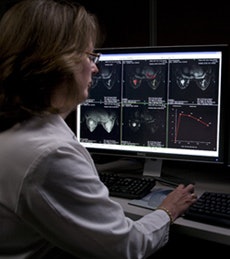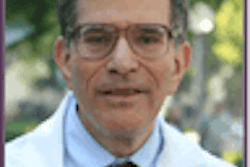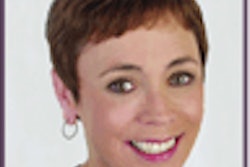As the concept of comprehensive breast centers reaches from well-funded academic institutions to the private center and community hospital setting, the one-stop-shop approach is not only increasing the quality of life for women with breast cancer, it is saving lives. The multidisciplinary approach creates coordinated care that benefits patients on multiple levels.
By eliminating a segmented approach to diagnosis, treatment, and follow-up, patients receive comprehensive care that removes the anxiety of protracted test results, the uncertainty of who is in charge of their care, and the need to travel to multiple sites. In addition to state-of-the-art imaging services, including mammography, ultrasound, and breast MRI, some centers offer patients psychological services and diet and fitness programs as part of a total wellness approach.
 Breast MRI is becoming accepted as a necessary tool at many comprehensive cancer centers. Image courtesy of Aurora Imaging Technology. |
Whether the comprehensive breast center is housed within the same walls or not, certain pivotal aspects are present, according to Barbara Rabinowitz, Ph.D., founder and trustee emeritus of the National Consortium of Breast Centers.
"They provide prospective consensus, treatment, planning [and] meetings," Rabinowitz said. "There's this whole interdisciplinary group of professionals who come together to discuss circumstance[s] ... along the trajectory when the woman's breast is believed to have cancer all the way through her treatments and adjuvant therapies."
Regular conferences with breast radiologists, breast surgeons, medical oncologists, and pathologists map out a patient's total treatment plan as part of the multidisciplinary approach.
In addition, a "breast navigator," a professional who could be a nurse, clinical social worker, or someone else, ensures patients move through the process in efficient fashion, in a way that makes them feel emotionally supported and with the education needed to make necessary decisions about their course of action.

“There's this whole interdisciplinary group
of professionals who
come together
[at comprehensive breast centers].”
— Barbara Rabinowitz, Ph.D.,
founder, National Consortium of
Breast Centers
In 1979, arguably the first comprehensive breast facility was the Breast Center, started in Van Nuys, CA, by Dr. Melvin Silverstein.
"It was a freestanding site," Rabinowitz said. "It ran on an interdisciplinary format, and so we always think of that center as the first identifiable, recognizable comprehensive breast center."
From those humble beginnings, the growth of comprehensive breast centers expands, with imaging playing a major role as healthcare becomes more disease-focused and specialists stress the need for coordinated care.
The evolution of treatment
M. D. Anderson Cancer Center in Houston has the advantage of possessing the resources needed to have state-of-the-art equipment in multiple modalities with respect to breast imaging, including peripheral support of a nuclear medicine center with a PET/CT scanner for women with metastatic disease.

“We're trying to do this very smooth transition from imaging, diagnosis, and a firm preliminary report that allows the patient to discuss possibilities with the clinician in one day.”
— Dr. Wei Tse Yang,
M. D. Anderson Cancer Center, Houston
M. D. Anderson's comprehensive breast center is housed on the fifth floor. The facility includes medical oncology clinics, breast surgical oncology clinics, breast radiation therapy clinics, a plastic surgery area, and a cancer prevention area. The center tries to complete a woman's imaging in the morning, followed immediately by a doctor visit, often with biopsy results available.
Breast MRI is housed one story down and is part of the entire MR imaging group. The breast center has dedicated slots for performing breast MRI. Because of housing issues and the equipment's specific needs, the breast MRI scanner is currently directly next door to the clinics.
The breast center also has onsite breast cytologists, allowing for immediate readings of biopsied cells. Within 10 minutes, the patient gets a preliminary result of positive or negative cells, which she hand-carries to her doctor. The outline for the treatment plan begins and is followed by the final report after 48 hours.
"That's the meaning of a comprehensive breast care center, where we're trying to do this very smooth transition from imaging, diagnosis, and a firm preliminary report that allows the patient to discuss possibilities with the clinician in one day," said Dr. Wei Tse Yang, chief of breast imaging.
Having an onsite cytologist is a rare and expensive luxury for the facility. Usually in a general practice, even if it's a comprehensive breast center, the cytologist would have to service multiple different organ sites to be cost-effective.
Quality of life
For any woman, a breast cancer diagnosis is life-altering. From the time of diagnosis, comprehensive breast centers work to coordinate care for every patient through information and support. Same-day results and in-person time impact the patient's quality of life. In addition, having one facility in charge from start to finish minimizes the chance of losing information in a shuffle.
Dr. Jennifer Engels, a diagnostic radiologist and breast specialist at Cooper Clinic in McKinney, TX, gives results of all screening mammograms in person the same day. The center also does extra views at the same time if they're needed. A written report follows in the mail, but each patient has the benefit of a discussion of the results prior to leaving the office.
"I think when people are worried about breast cancer, any day that they have to wait is very significant in the quality of life," Engels said.
A second radiologist does second reads on all mammograms. If the second radiologist is not in agreement or sees something additional, the two radiologists review the findings together and decide whether additional tests are needed. If the woman is still available, the center performs more tests immediately.
In addition to the second reads, radiologists at Cooper Clinic also use computer-aided detection (CAD) on their digitally acquired mammograms. With CAD, some imaging centers drop the second reads, but the center plans to maintain its approach as volume grows, Engels said. The center's practice is building and has between 50 and 60 patients per month.
For biopsies, the local pathology lab provides results within 24 hours. Following the report, Engels and the oncoplastic surgeon work closely and discuss the kind of surgery needed. The approach speeds up the entire process, allowing women to know what is happening sooner.
Cooper Clinic's breast MRI scanner came on board in August, and the system has a built-in MRI biopsy component. So if a lesion can be detected by ultrasound and a biopsy is needed, an ultrasound biopsy would be used. If the area can't be detected on ultrasound but is suspicious due to its appearance on MRI, the surgeon will do an MRI-guided biopsy.
Changing patient care
Unfortunately, timely diagnosis often escapes some imaging sites. In one case, a woman had a mammogram with abnormal findings. Another imaging center told her she would have to wait three weeks for a follow-up appointment, but she was leaving for vacation, and her anxiety over the mammogram's results was building.

“It can really make a difference in someone's quality of life if we can take care of it right then and answer the question.”
— Dr. Jennifer Engels,
Cooper Clinic, McKinney, TX
The Cooper Clinic breast center was able to see her the same day she called. Engels took new views and was able to assure the woman that there was no evidence of cancer. An immediate answer eliminated three weeks of unnecessary anxiety.
"She literally broke down in tears and was the most thankful person you'd ever seen ... I was able to resolve this problem before she went on vacation," Engels said. "That's just one example of how it can really make a difference in someone's quality of life if we can take care of it right then and answer the question."
Sometimes incorporating breast MRI can mean needing more time to address problems. But getting it right the first time takes precedence.
"In the long run, it's better to be as thorough as possible up-front, even though it can take a couple of extra days," Engels said. "If you can save that patient one more surgery, that is huge."
The amount of healthcare savings from comprehensive breast care centers, and the difference they make in a patient's recovery time and mental and physical states, can't be calculated. But the growth of such centers is testament to their effectiveness.

“It's a good model
for women to have
coordinated care between all
the physicians ...
on a single site.”
— Dr. Kamilia Kozlowski,
Knoxville Comprehensive Breast Center, Knoxville, TN
"The [number] of comprehensive breast centers has been progressively increasing during the last 10 years in recognition that it's a good model for women to have coordinated care between all the physicians ... on a single site," said Dr. Kamilia Kozlowski, clinical director and CEO of Knoxville Comprehensive Breast Center in Tennessee. "Otherwise, with separate appointments between physicians' offices with specialists in different locations, it's so easy for information to fall between the cracks and not be conveyed from one physician to the other."
Absence of the comprehensive approach also makes patients wonder who is in charge of their care. But patients should be careful of what's in a name. Not all facilities that call themselves comprehensive breast centers actually are. Coordinated care is key to the concept.
"It's not coordinated care [if] the diagnostic imaging is done separately," Kozlowski said. "Any questions, then the patient goes to a surgeon's office, which may be in a different location, and not all cases are discussed pre- and postsurgery."
Variation exists among comprehensive breast centers. The common characteristic among them all should be the ability to diagnose, treat, and follow patients. Multidisciplinary conferences also are a major component in this approach, discussing in detail what specialists find, ensuring that nothing is missed on pathology. Everything is covered regarding treatment, including neoadjuvant chemotherapy and radiation therapy if needed.
Knoxville Comprehensive Breast Center began operations 10 years ago. Its coordinated care approach includes multidisciplinary conferences that are attended by 100% of the specialists. As treatment of breast cancer has evolved over the years, the multidisciplinary approach has taken on new importance in covering various treatment options.
"With the recognition of the different tumor types, there are all kinds of different regimens," Kozlowski said. "All aspects of their treatment are covered by the specialists, and we're all communicating with each other. There's a consensus of opinion as far as each individual woman's treatment because it is so varied from one woman to the next."
One specialist that Kozlowski sees as absolutely necessary in a comprehensive breast center is a dedicated breast radiologist. And a necessary part of diagnosis is breast MRI in conjunction with mammography and ultrasound.
"The real foundation of a comprehensive breast care center is the diagnostics," Kozlowski said. "You really can't practice complete diagnostic breast care unless you have an MRI."
At Knoxville, all studies, including stereotactic, ultrasound, and MRI-guided biopsies, are completed on the same day. When a patient comes through for her diagnostic examination and further workup is needed, it is done immediately. By the time she leaves, she has the results. The radiologist provides the patient with an idea of what has been found, and the pathology results come within 24 to 48 hours. If the exam turns out to be negative, the patient knows before leaving the office.
The center also offers physical therapy offsite. A therapist will join the staff next year when a new comprehensive cancer center opens. A lymphedema specialist currently attends the multidisciplinary meetings. Patients at high risk for developing lymphedema, either before or after treatment, work with the physical therapist. In the future, the center will add wellness and nutrition programs.
Personal experience
As a breast cancer survivor, Dr. Lillian Chou, a radiation oncologist at Radiation Oncology of the South Plains in Lubbock, TX, has a personal passion and commitment to offering the best comprehensive services to fight breast cancer. She is the first radiation oncologist to purchase a dedicated breast MRI scanner, and she has found that its contrast and resolution are superior to whole-body machines used for breast imaging.

“This model ... with the community cancer center, the community breast center, and community imaging all in one is the future.”
— Dr. Lillian Chou,
Radiation Oncology of the South Plains, Lubbock, TX
Chou's center does 150 to 180 mammograms per month, and offers walk-in mammograms. And with low volume, it can also perform breast MRI with a patient's appropriate diagnosis and insurance agreement.
In addition to digital mammography, ultrasound, breast biopsy, and breast MRI, the center has PET and CT scans for patients with invasive cancer. Chou's center is a private practice and uses community physicians.
"We participate in conferences at the hospital, so if there was any question about management, we can take our cases there to the conference, and there we have community doctors and the academic doctors," Chou said. "You can do consensus on difficult cases."
Chou started her breast center seven years ago with the idea of combining the comprehensive breast center with the cancer center and including other imaging like PET/CT.
"I think ... this model that I have with the community cancer center, the community breast center, and community imaging all in one is the future," Chou said. "It's just a matter of a mindset of getting the financial resources and the human resources to team up together, and it can be done in a community setting."
By Lin Muschlitz
AuntMinnie.com contributing writer
September 2, 2008
Copyright © 2008 AuntMinnie.com



















